Business Law Report: Legal System's Impact on Business in the UK
VerifiedAdded on 2022/11/28
|11
|3668
|418
Report
AI Summary
This report provides a comprehensive overview of business law within the United Kingdom. It begins by outlining the sources of law and the government's role in law-making, including the legislative process. The report then examines the application of statutory and common laws by judicial courts, and assesses the legal system's adaptability to current advancements. Key areas of business law, such as contract law, company law, and employment law, are explored, detailing their influence on business operations and relationships. The report clarifies the distinctions between laws, regulations, and standards, followed by an analysis of different types of legal enterprises, their formation, management, and funding. Finally, it discusses dispute resolution methods, providing a complete understanding of the legal environment for businesses in the UK.
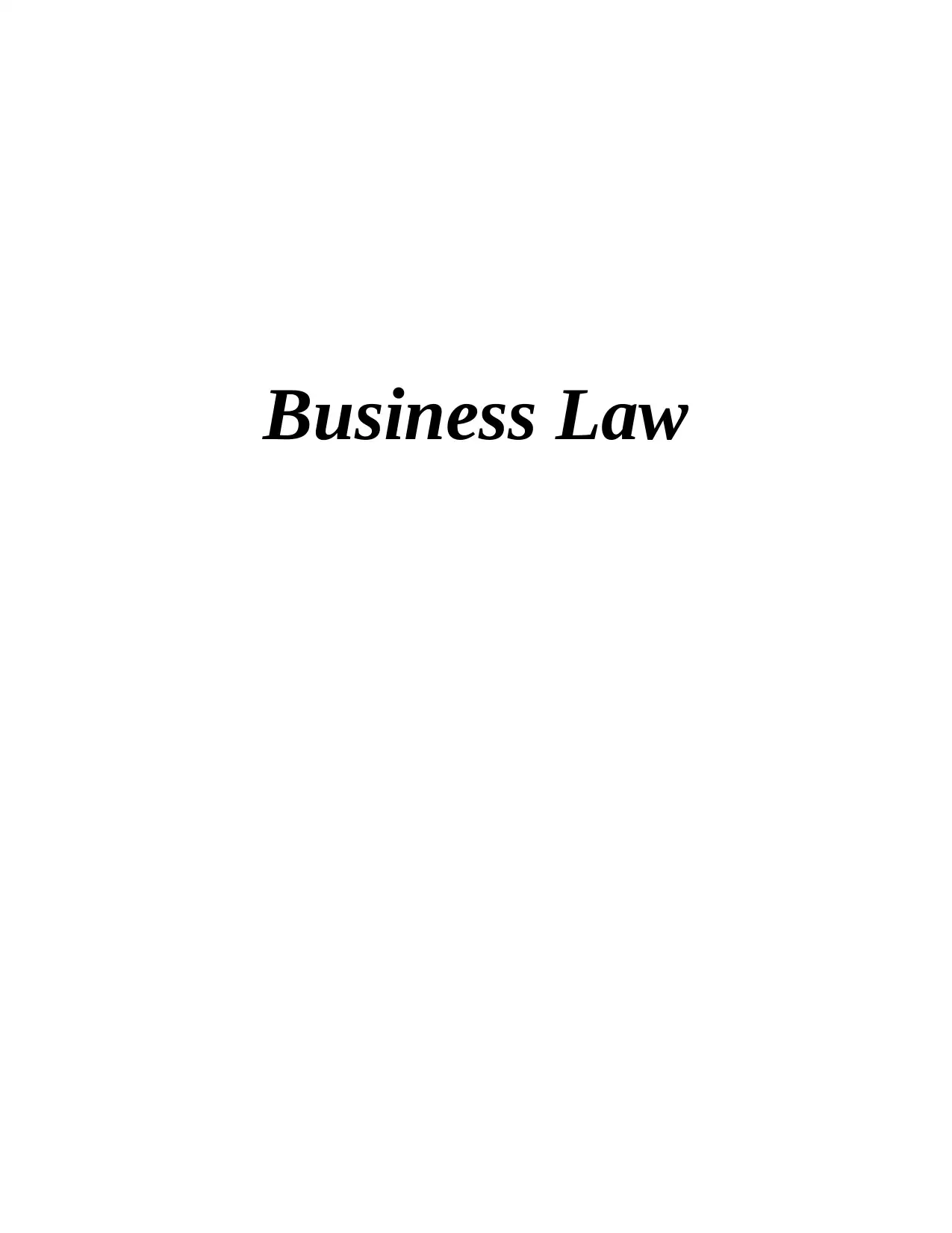
Business Law
Paraphrase This Document
Need a fresh take? Get an instant paraphrase of this document with our AI Paraphraser
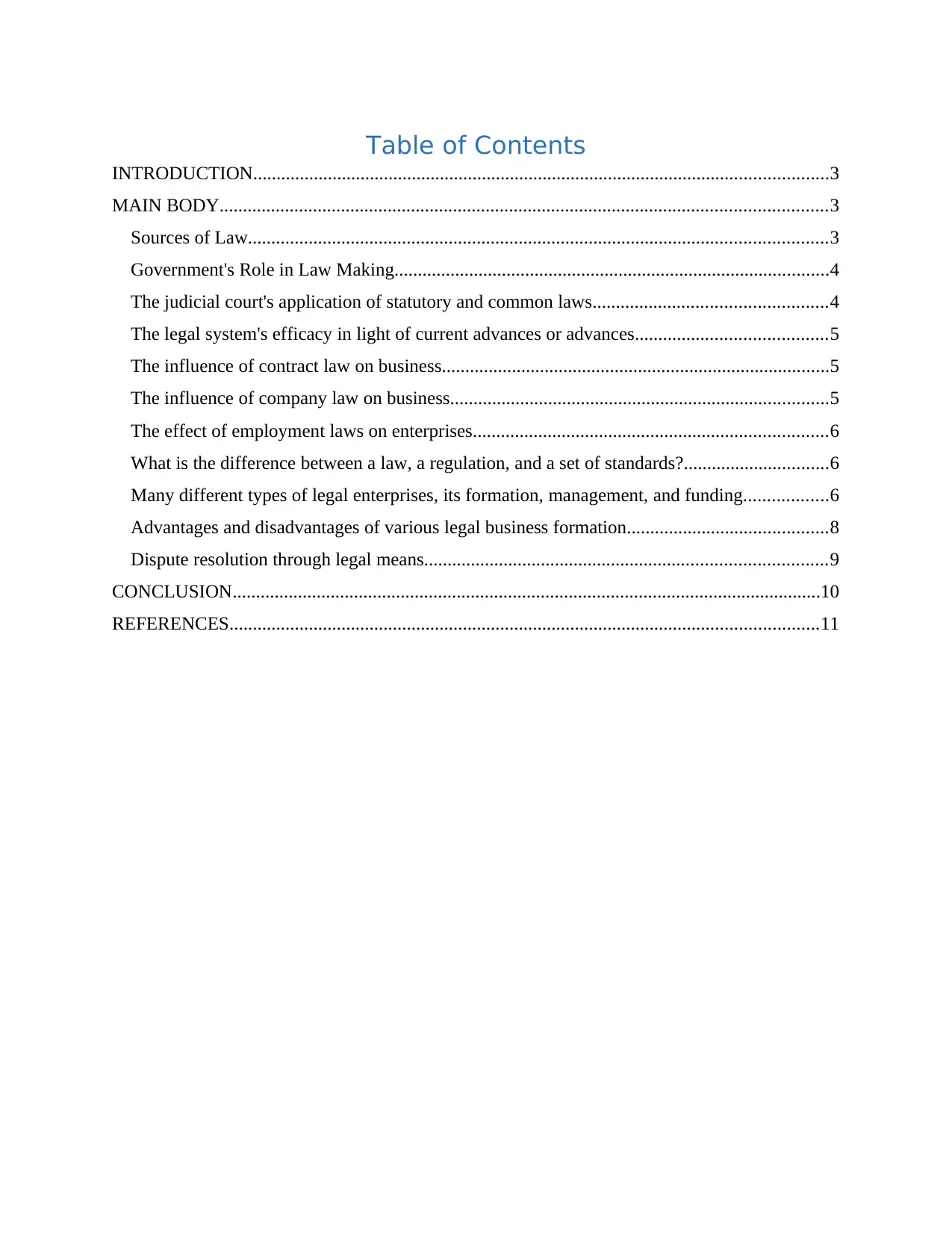
Table of Contents
INTRODUCTION...........................................................................................................................3
MAIN BODY..................................................................................................................................3
Sources of Law............................................................................................................................3
Government's Role in Law Making.............................................................................................4
The judicial court's application of statutory and common laws..................................................4
The legal system's efficacy in light of current advances or advances.........................................5
The influence of contract law on business...................................................................................5
The influence of company law on business.................................................................................5
The effect of employment laws on enterprises............................................................................6
What is the difference between a law, a regulation, and a set of standards?...............................6
Many different types of legal enterprises, its formation, management, and funding..................6
Advantages and disadvantages of various legal business formation...........................................8
Dispute resolution through legal means......................................................................................9
CONCLUSION..............................................................................................................................10
REFERENCES..............................................................................................................................11
INTRODUCTION...........................................................................................................................3
MAIN BODY..................................................................................................................................3
Sources of Law............................................................................................................................3
Government's Role in Law Making.............................................................................................4
The judicial court's application of statutory and common laws..................................................4
The legal system's efficacy in light of current advances or advances.........................................5
The influence of contract law on business...................................................................................5
The influence of company law on business.................................................................................5
The effect of employment laws on enterprises............................................................................6
What is the difference between a law, a regulation, and a set of standards?...............................6
Many different types of legal enterprises, its formation, management, and funding..................6
Advantages and disadvantages of various legal business formation...........................................8
Dispute resolution through legal means......................................................................................9
CONCLUSION..............................................................................................................................10
REFERENCES..............................................................................................................................11
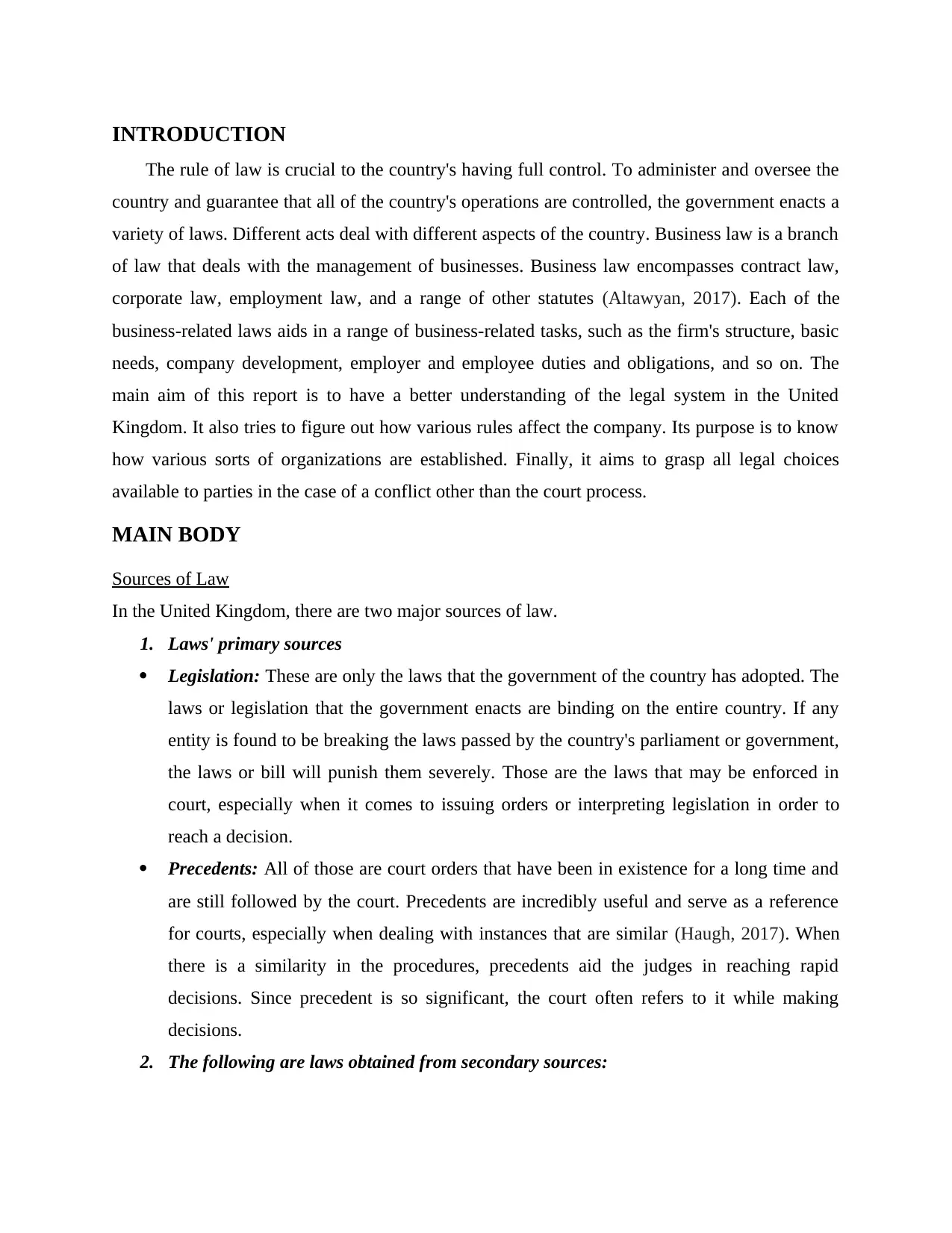
INTRODUCTION
The rule of law is crucial to the country's having full control. To administer and oversee the
country and guarantee that all of the country's operations are controlled, the government enacts a
variety of laws. Different acts deal with different aspects of the country. Business law is a branch
of law that deals with the management of businesses. Business law encompasses contract law,
corporate law, employment law, and a range of other statutes (Altawyan, 2017). Each of the
business-related laws aids in a range of business-related tasks, such as the firm's structure, basic
needs, company development, employer and employee duties and obligations, and so on. The
main aim of this report is to have a better understanding of the legal system in the United
Kingdom. It also tries to figure out how various rules affect the company. Its purpose is to know
how various sorts of organizations are established. Finally, it aims to grasp all legal choices
available to parties in the case of a conflict other than the court process.
MAIN BODY
Sources of Law
In the United Kingdom, there are two major sources of law.
1. Laws' primary sources
Legislation: These are only the laws that the government of the country has adopted. The
laws or legislation that the government enacts are binding on the entire country. If any
entity is found to be breaking the laws passed by the country's parliament or government,
the laws or bill will punish them severely. Those are the laws that may be enforced in
court, especially when it comes to issuing orders or interpreting legislation in order to
reach a decision.
Precedents: All of those are court orders that have been in existence for a long time and
are still followed by the court. Precedents are incredibly useful and serve as a reference
for courts, especially when dealing with instances that are similar (Haugh, 2017). When
there is a similarity in the procedures, precedents aid the judges in reaching rapid
decisions. Since precedent is so significant, the court often refers to it while making
decisions.
2. The following are laws obtained from secondary sources:
The rule of law is crucial to the country's having full control. To administer and oversee the
country and guarantee that all of the country's operations are controlled, the government enacts a
variety of laws. Different acts deal with different aspects of the country. Business law is a branch
of law that deals with the management of businesses. Business law encompasses contract law,
corporate law, employment law, and a range of other statutes (Altawyan, 2017). Each of the
business-related laws aids in a range of business-related tasks, such as the firm's structure, basic
needs, company development, employer and employee duties and obligations, and so on. The
main aim of this report is to have a better understanding of the legal system in the United
Kingdom. It also tries to figure out how various rules affect the company. Its purpose is to know
how various sorts of organizations are established. Finally, it aims to grasp all legal choices
available to parties in the case of a conflict other than the court process.
MAIN BODY
Sources of Law
In the United Kingdom, there are two major sources of law.
1. Laws' primary sources
Legislation: These are only the laws that the government of the country has adopted. The
laws or legislation that the government enacts are binding on the entire country. If any
entity is found to be breaking the laws passed by the country's parliament or government,
the laws or bill will punish them severely. Those are the laws that may be enforced in
court, especially when it comes to issuing orders or interpreting legislation in order to
reach a decision.
Precedents: All of those are court orders that have been in existence for a long time and
are still followed by the court. Precedents are incredibly useful and serve as a reference
for courts, especially when dealing with instances that are similar (Haugh, 2017). When
there is a similarity in the procedures, precedents aid the judges in reaching rapid
decisions. Since precedent is so significant, the court often refers to it while making
decisions.
2. The following are laws obtained from secondary sources:
⊘ This is a preview!⊘
Do you want full access?
Subscribe today to unlock all pages.

Trusted by 1+ million students worldwide
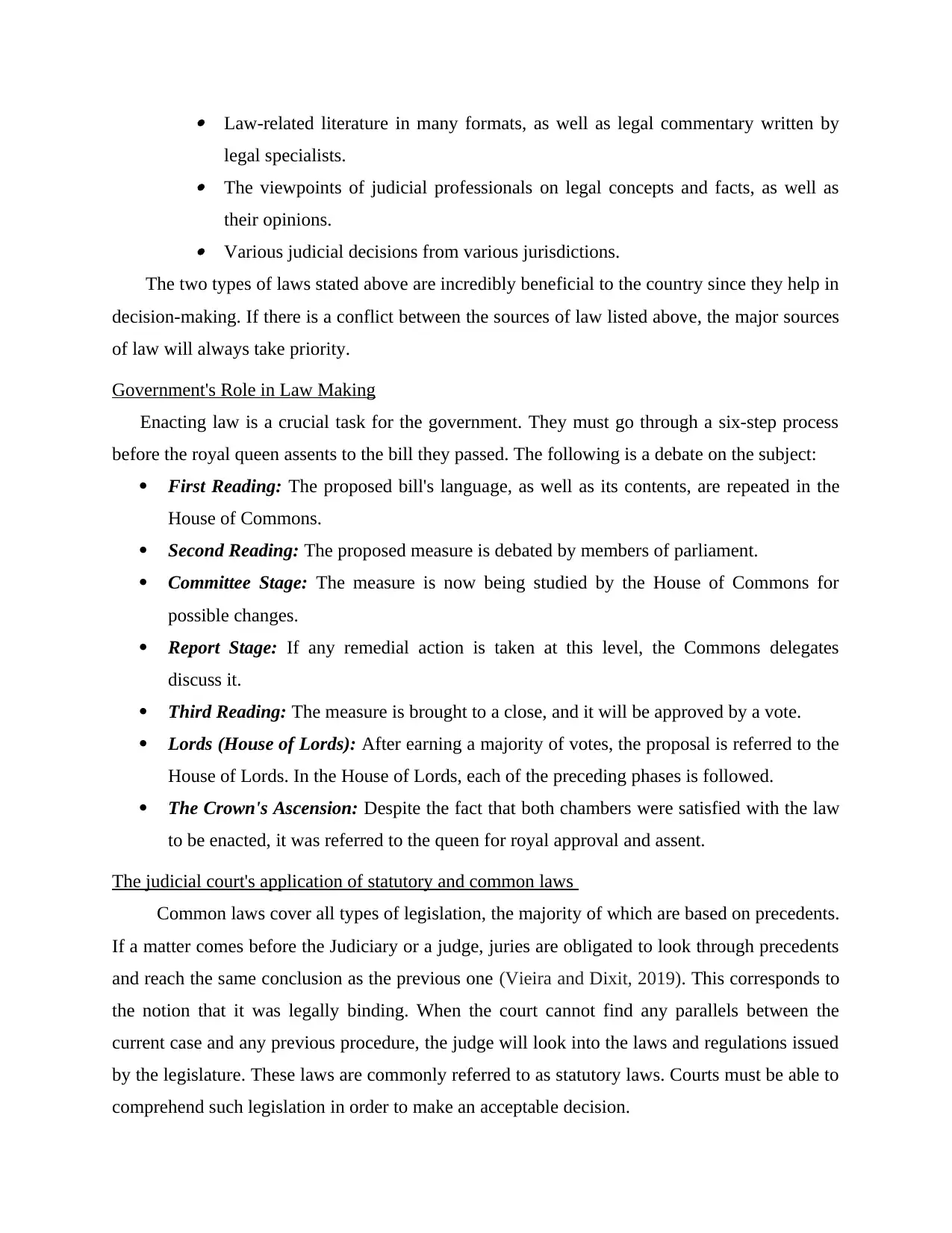
Law-related literature in many formats, as well as legal commentary written by
legal specialists.
The viewpoints of judicial professionals on legal concepts and facts, as well as
their opinions.
Various judicial decisions from various jurisdictions.
The two types of laws stated above are incredibly beneficial to the country since they help in
decision-making. If there is a conflict between the sources of law listed above, the major sources
of law will always take priority.
Government's Role in Law Making
Enacting law is a crucial task for the government. They must go through a six-step process
before the royal queen assents to the bill they passed. The following is a debate on the subject:
First Reading: The proposed bill's language, as well as its contents, are repeated in the
House of Commons.
Second Reading: The proposed measure is debated by members of parliament.
Committee Stage: The measure is now being studied by the House of Commons for
possible changes.
Report Stage: If any remedial action is taken at this level, the Commons delegates
discuss it.
Third Reading: The measure is brought to a close, and it will be approved by a vote.
Lords (House of Lords): After earning a majority of votes, the proposal is referred to the
House of Lords. In the House of Lords, each of the preceding phases is followed.
The Crown's Ascension: Despite the fact that both chambers were satisfied with the law
to be enacted, it was referred to the queen for royal approval and assent.
The judicial court's application of statutory and common laws
Common laws cover all types of legislation, the majority of which are based on precedents.
If a matter comes before the Judiciary or a judge, juries are obligated to look through precedents
and reach the same conclusion as the previous one (Vieira and Dixit, 2019). This corresponds to
the notion that it was legally binding. When the court cannot find any parallels between the
current case and any previous procedure, the judge will look into the laws and regulations issued
by the legislature. These laws are commonly referred to as statutory laws. Courts must be able to
comprehend such legislation in order to make an acceptable decision.
legal specialists.
The viewpoints of judicial professionals on legal concepts and facts, as well as
their opinions.
Various judicial decisions from various jurisdictions.
The two types of laws stated above are incredibly beneficial to the country since they help in
decision-making. If there is a conflict between the sources of law listed above, the major sources
of law will always take priority.
Government's Role in Law Making
Enacting law is a crucial task for the government. They must go through a six-step process
before the royal queen assents to the bill they passed. The following is a debate on the subject:
First Reading: The proposed bill's language, as well as its contents, are repeated in the
House of Commons.
Second Reading: The proposed measure is debated by members of parliament.
Committee Stage: The measure is now being studied by the House of Commons for
possible changes.
Report Stage: If any remedial action is taken at this level, the Commons delegates
discuss it.
Third Reading: The measure is brought to a close, and it will be approved by a vote.
Lords (House of Lords): After earning a majority of votes, the proposal is referred to the
House of Lords. In the House of Lords, each of the preceding phases is followed.
The Crown's Ascension: Despite the fact that both chambers were satisfied with the law
to be enacted, it was referred to the queen for royal approval and assent.
The judicial court's application of statutory and common laws
Common laws cover all types of legislation, the majority of which are based on precedents.
If a matter comes before the Judiciary or a judge, juries are obligated to look through precedents
and reach the same conclusion as the previous one (Vieira and Dixit, 2019). This corresponds to
the notion that it was legally binding. When the court cannot find any parallels between the
current case and any previous procedure, the judge will look into the laws and regulations issued
by the legislature. These laws are commonly referred to as statutory laws. Courts must be able to
comprehend such legislation in order to make an acceptable decision.
Paraphrase This Document
Need a fresh take? Get an instant paraphrase of this document with our AI Paraphraser
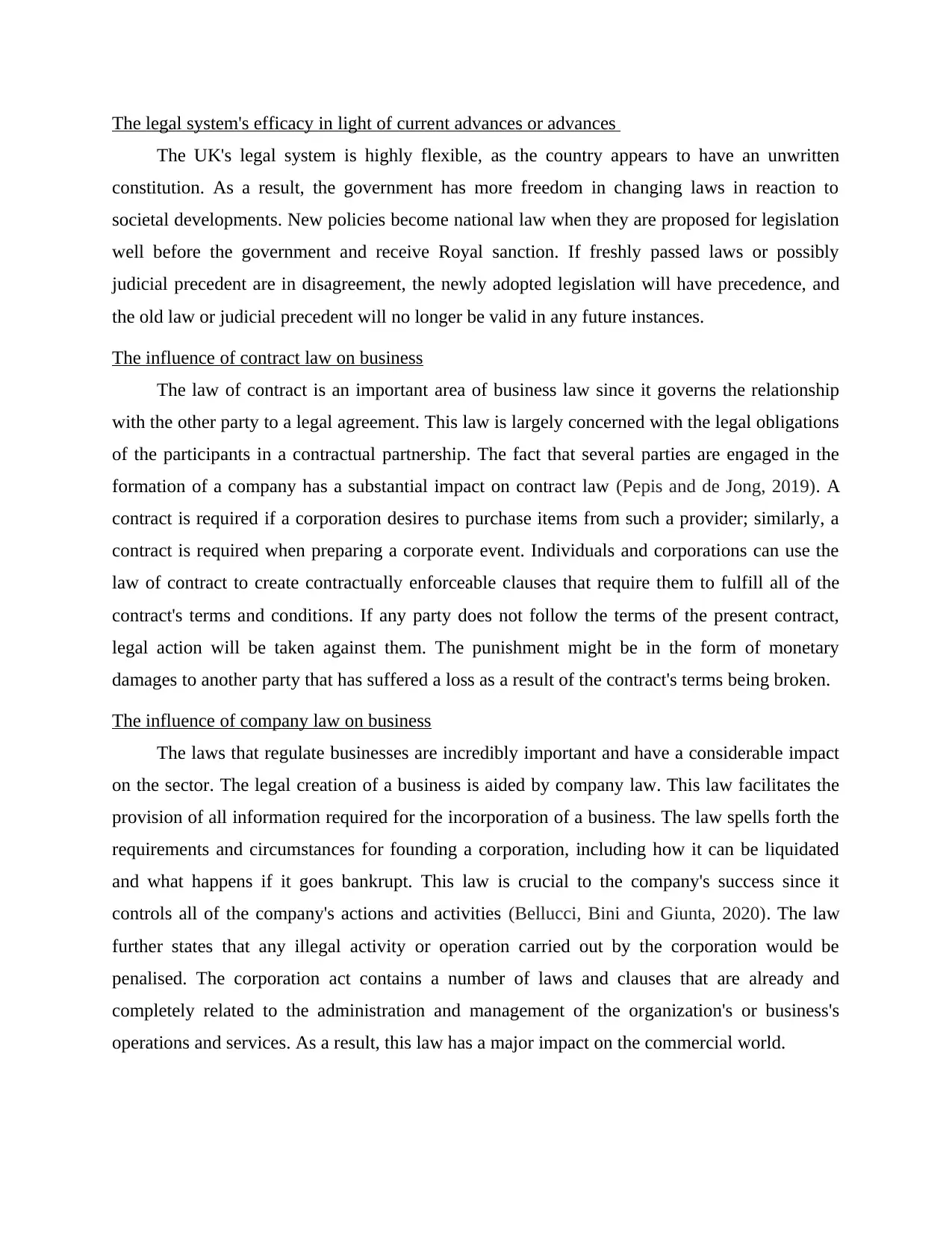
The legal system's efficacy in light of current advances or advances
The UK's legal system is highly flexible, as the country appears to have an unwritten
constitution. As a result, the government has more freedom in changing laws in reaction to
societal developments. New policies become national law when they are proposed for legislation
well before the government and receive Royal sanction. If freshly passed laws or possibly
judicial precedent are in disagreement, the newly adopted legislation will have precedence, and
the old law or judicial precedent will no longer be valid in any future instances.
The influence of contract law on business
The law of contract is an important area of business law since it governs the relationship
with the other party to a legal agreement. This law is largely concerned with the legal obligations
of the participants in a contractual partnership. The fact that several parties are engaged in the
formation of a company has a substantial impact on contract law (Pepis and de Jong, 2019). A
contract is required if a corporation desires to purchase items from such a provider; similarly, a
contract is required when preparing a corporate event. Individuals and corporations can use the
law of contract to create contractually enforceable clauses that require them to fulfill all of the
contract's terms and conditions. If any party does not follow the terms of the present contract,
legal action will be taken against them. The punishment might be in the form of monetary
damages to another party that has suffered a loss as a result of the contract's terms being broken.
The influence of company law on business
The laws that regulate businesses are incredibly important and have a considerable impact
on the sector. The legal creation of a business is aided by company law. This law facilitates the
provision of all information required for the incorporation of a business. The law spells forth the
requirements and circumstances for founding a corporation, including how it can be liquidated
and what happens if it goes bankrupt. This law is crucial to the company's success since it
controls all of the company's actions and activities (Bellucci, Bini and Giunta, 2020). The law
further states that any illegal activity or operation carried out by the corporation would be
penalised. The corporation act contains a number of laws and clauses that are already and
completely related to the administration and management of the organization's or business's
operations and services. As a result, this law has a major impact on the commercial world.
The UK's legal system is highly flexible, as the country appears to have an unwritten
constitution. As a result, the government has more freedom in changing laws in reaction to
societal developments. New policies become national law when they are proposed for legislation
well before the government and receive Royal sanction. If freshly passed laws or possibly
judicial precedent are in disagreement, the newly adopted legislation will have precedence, and
the old law or judicial precedent will no longer be valid in any future instances.
The influence of contract law on business
The law of contract is an important area of business law since it governs the relationship
with the other party to a legal agreement. This law is largely concerned with the legal obligations
of the participants in a contractual partnership. The fact that several parties are engaged in the
formation of a company has a substantial impact on contract law (Pepis and de Jong, 2019). A
contract is required if a corporation desires to purchase items from such a provider; similarly, a
contract is required when preparing a corporate event. Individuals and corporations can use the
law of contract to create contractually enforceable clauses that require them to fulfill all of the
contract's terms and conditions. If any party does not follow the terms of the present contract,
legal action will be taken against them. The punishment might be in the form of monetary
damages to another party that has suffered a loss as a result of the contract's terms being broken.
The influence of company law on business
The laws that regulate businesses are incredibly important and have a considerable impact
on the sector. The legal creation of a business is aided by company law. This law facilitates the
provision of all information required for the incorporation of a business. The law spells forth the
requirements and circumstances for founding a corporation, including how it can be liquidated
and what happens if it goes bankrupt. This law is crucial to the company's success since it
controls all of the company's actions and activities (Bellucci, Bini and Giunta, 2020). The law
further states that any illegal activity or operation carried out by the corporation would be
penalised. The corporation act contains a number of laws and clauses that are already and
completely related to the administration and management of the organization's or business's
operations and services. As a result, this law has a major impact on the commercial world.
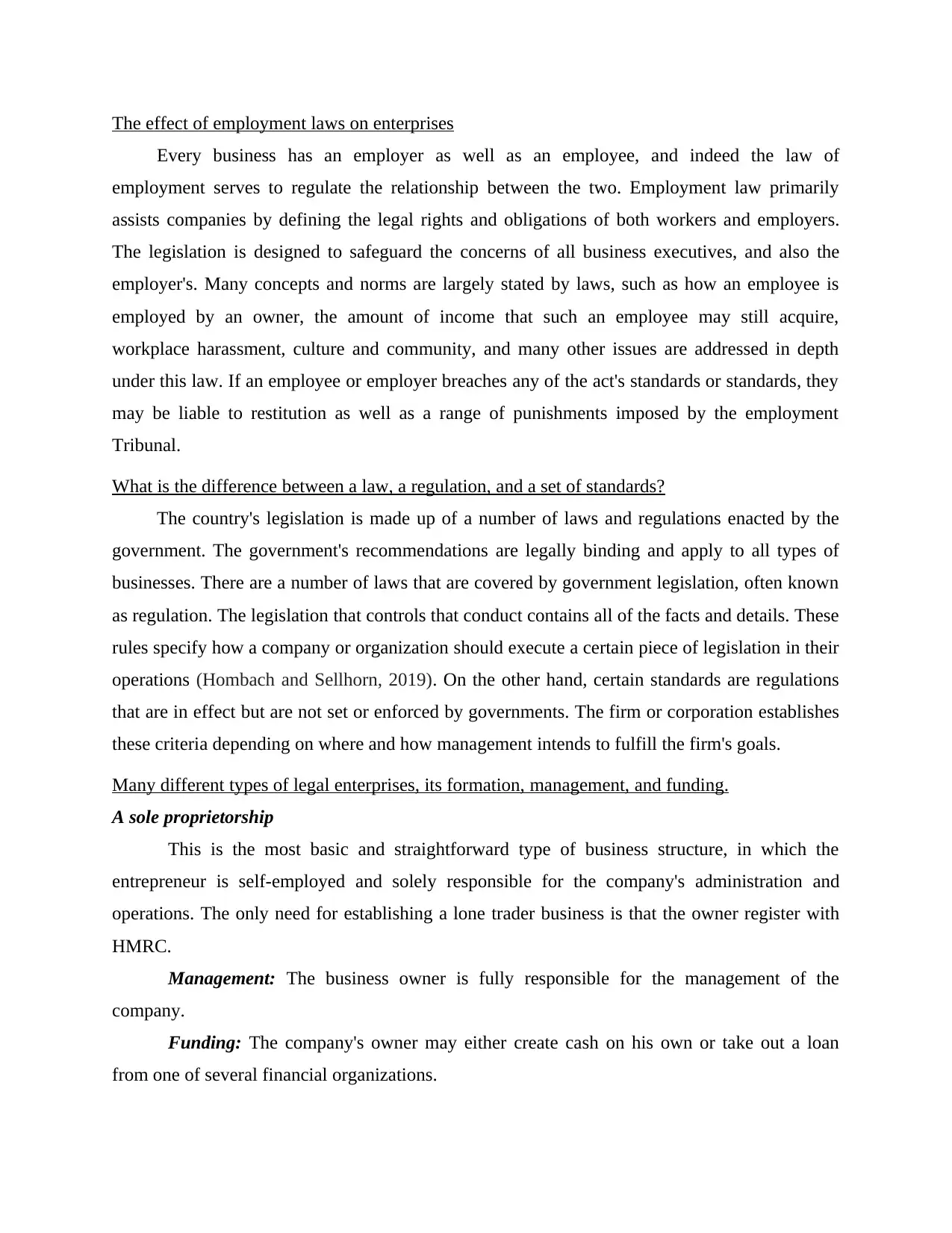
The effect of employment laws on enterprises
Every business has an employer as well as an employee, and indeed the law of
employment serves to regulate the relationship between the two. Employment law primarily
assists companies by defining the legal rights and obligations of both workers and employers.
The legislation is designed to safeguard the concerns of all business executives, and also the
employer's. Many concepts and norms are largely stated by laws, such as how an employee is
employed by an owner, the amount of income that such an employee may still acquire,
workplace harassment, culture and community, and many other issues are addressed in depth
under this law. If an employee or employer breaches any of the act's standards or standards, they
may be liable to restitution as well as a range of punishments imposed by the employment
Tribunal.
What is the difference between a law, a regulation, and a set of standards?
The country's legislation is made up of a number of laws and regulations enacted by the
government. The government's recommendations are legally binding and apply to all types of
businesses. There are a number of laws that are covered by government legislation, often known
as regulation. The legislation that controls that conduct contains all of the facts and details. These
rules specify how a company or organization should execute a certain piece of legislation in their
operations (Hombach and Sellhorn, 2019). On the other hand, certain standards are regulations
that are in effect but are not set or enforced by governments. The firm or corporation establishes
these criteria depending on where and how management intends to fulfill the firm's goals.
Many different types of legal enterprises, its formation, management, and funding.
A sole proprietorship
This is the most basic and straightforward type of business structure, in which the
entrepreneur is self-employed and solely responsible for the company's administration and
operations. The only need for establishing a lone trader business is that the owner register with
HMRC.
Management: The business owner is fully responsible for the management of the
company.
Funding: The company's owner may either create cash on his own or take out a loan
from one of several financial organizations.
Every business has an employer as well as an employee, and indeed the law of
employment serves to regulate the relationship between the two. Employment law primarily
assists companies by defining the legal rights and obligations of both workers and employers.
The legislation is designed to safeguard the concerns of all business executives, and also the
employer's. Many concepts and norms are largely stated by laws, such as how an employee is
employed by an owner, the amount of income that such an employee may still acquire,
workplace harassment, culture and community, and many other issues are addressed in depth
under this law. If an employee or employer breaches any of the act's standards or standards, they
may be liable to restitution as well as a range of punishments imposed by the employment
Tribunal.
What is the difference between a law, a regulation, and a set of standards?
The country's legislation is made up of a number of laws and regulations enacted by the
government. The government's recommendations are legally binding and apply to all types of
businesses. There are a number of laws that are covered by government legislation, often known
as regulation. The legislation that controls that conduct contains all of the facts and details. These
rules specify how a company or organization should execute a certain piece of legislation in their
operations (Hombach and Sellhorn, 2019). On the other hand, certain standards are regulations
that are in effect but are not set or enforced by governments. The firm or corporation establishes
these criteria depending on where and how management intends to fulfill the firm's goals.
Many different types of legal enterprises, its formation, management, and funding.
A sole proprietorship
This is the most basic and straightforward type of business structure, in which the
entrepreneur is self-employed and solely responsible for the company's administration and
operations. The only need for establishing a lone trader business is that the owner register with
HMRC.
Management: The business owner is fully responsible for the management of the
company.
Funding: The company's owner may either create cash on his own or take out a loan
from one of several financial organizations.
⊘ This is a preview!⊘
Do you want full access?
Subscribe today to unlock all pages.

Trusted by 1+ million students worldwide
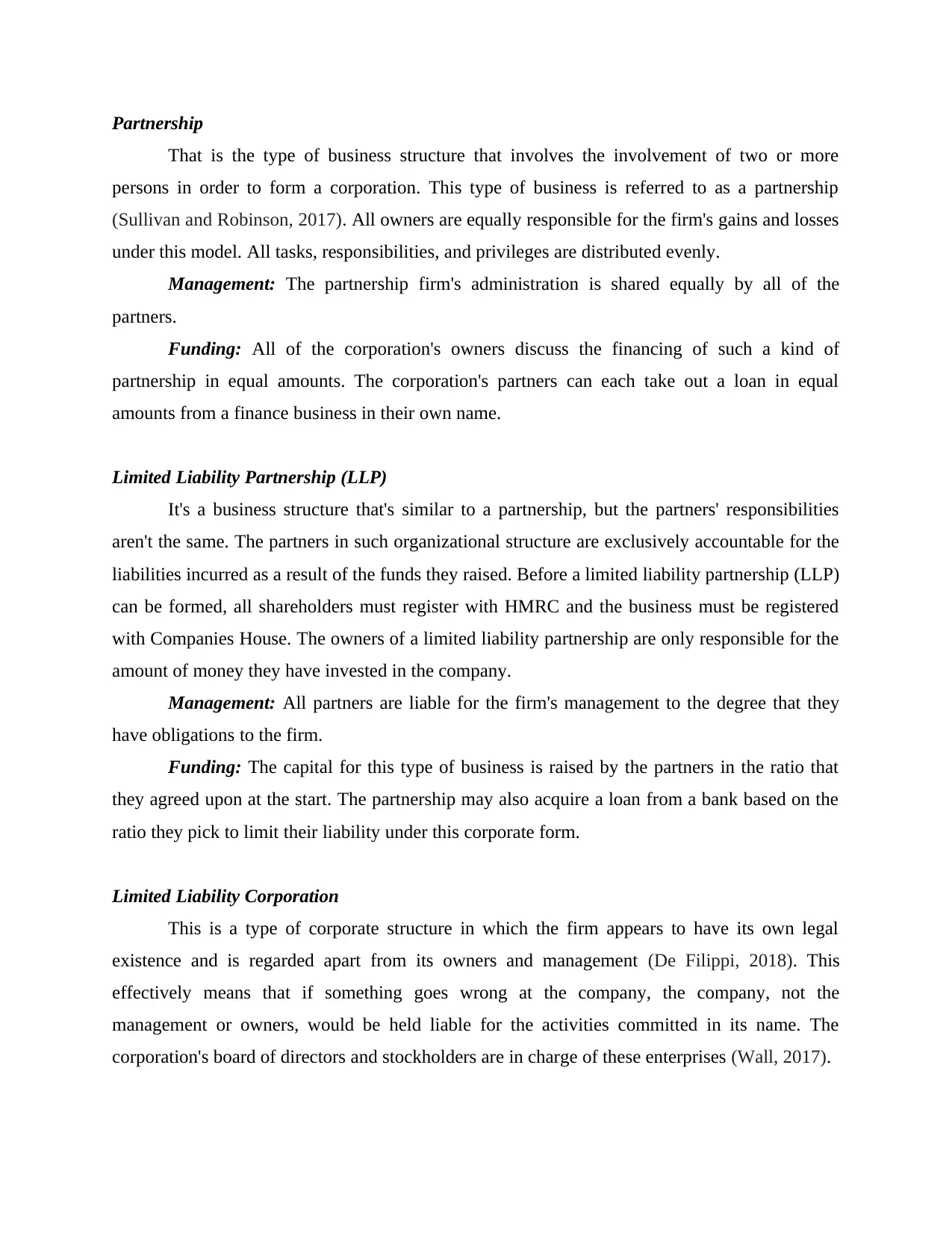
Partnership
That is the type of business structure that involves the involvement of two or more
persons in order to form a corporation. This type of business is referred to as a partnership
(Sullivan and Robinson, 2017). All owners are equally responsible for the firm's gains and losses
under this model. All tasks, responsibilities, and privileges are distributed evenly.
Management: The partnership firm's administration is shared equally by all of the
partners.
Funding: All of the corporation's owners discuss the financing of such a kind of
partnership in equal amounts. The corporation's partners can each take out a loan in equal
amounts from a finance business in their own name.
Limited Liability Partnership (LLP)
It's a business structure that's similar to a partnership, but the partners' responsibilities
aren't the same. The partners in such organizational structure are exclusively accountable for the
liabilities incurred as a result of the funds they raised. Before a limited liability partnership (LLP)
can be formed, all shareholders must register with HMRC and the business must be registered
with Companies House. The owners of a limited liability partnership are only responsible for the
amount of money they have invested in the company.
Management: All partners are liable for the firm's management to the degree that they
have obligations to the firm.
Funding: The capital for this type of business is raised by the partners in the ratio that
they agreed upon at the start. The partnership may also acquire a loan from a bank based on the
ratio they pick to limit their liability under this corporate form.
Limited Liability Corporation
This is a type of corporate structure in which the firm appears to have its own legal
existence and is regarded apart from its owners and management (De Filippi, 2018). This
effectively means that if something goes wrong at the company, the company, not the
management or owners, would be held liable for the activities committed in its name. The
corporation's board of directors and stockholders are in charge of these enterprises (Wall, 2017).
That is the type of business structure that involves the involvement of two or more
persons in order to form a corporation. This type of business is referred to as a partnership
(Sullivan and Robinson, 2017). All owners are equally responsible for the firm's gains and losses
under this model. All tasks, responsibilities, and privileges are distributed evenly.
Management: The partnership firm's administration is shared equally by all of the
partners.
Funding: All of the corporation's owners discuss the financing of such a kind of
partnership in equal amounts. The corporation's partners can each take out a loan in equal
amounts from a finance business in their own name.
Limited Liability Partnership (LLP)
It's a business structure that's similar to a partnership, but the partners' responsibilities
aren't the same. The partners in such organizational structure are exclusively accountable for the
liabilities incurred as a result of the funds they raised. Before a limited liability partnership (LLP)
can be formed, all shareholders must register with HMRC and the business must be registered
with Companies House. The owners of a limited liability partnership are only responsible for the
amount of money they have invested in the company.
Management: All partners are liable for the firm's management to the degree that they
have obligations to the firm.
Funding: The capital for this type of business is raised by the partners in the ratio that
they agreed upon at the start. The partnership may also acquire a loan from a bank based on the
ratio they pick to limit their liability under this corporate form.
Limited Liability Corporation
This is a type of corporate structure in which the firm appears to have its own legal
existence and is regarded apart from its owners and management (De Filippi, 2018). This
effectively means that if something goes wrong at the company, the company, not the
management or owners, would be held liable for the activities committed in its name. The
corporation's board of directors and stockholders are in charge of these enterprises (Wall, 2017).
Paraphrase This Document
Need a fresh take? Get an instant paraphrase of this document with our AI Paraphraser
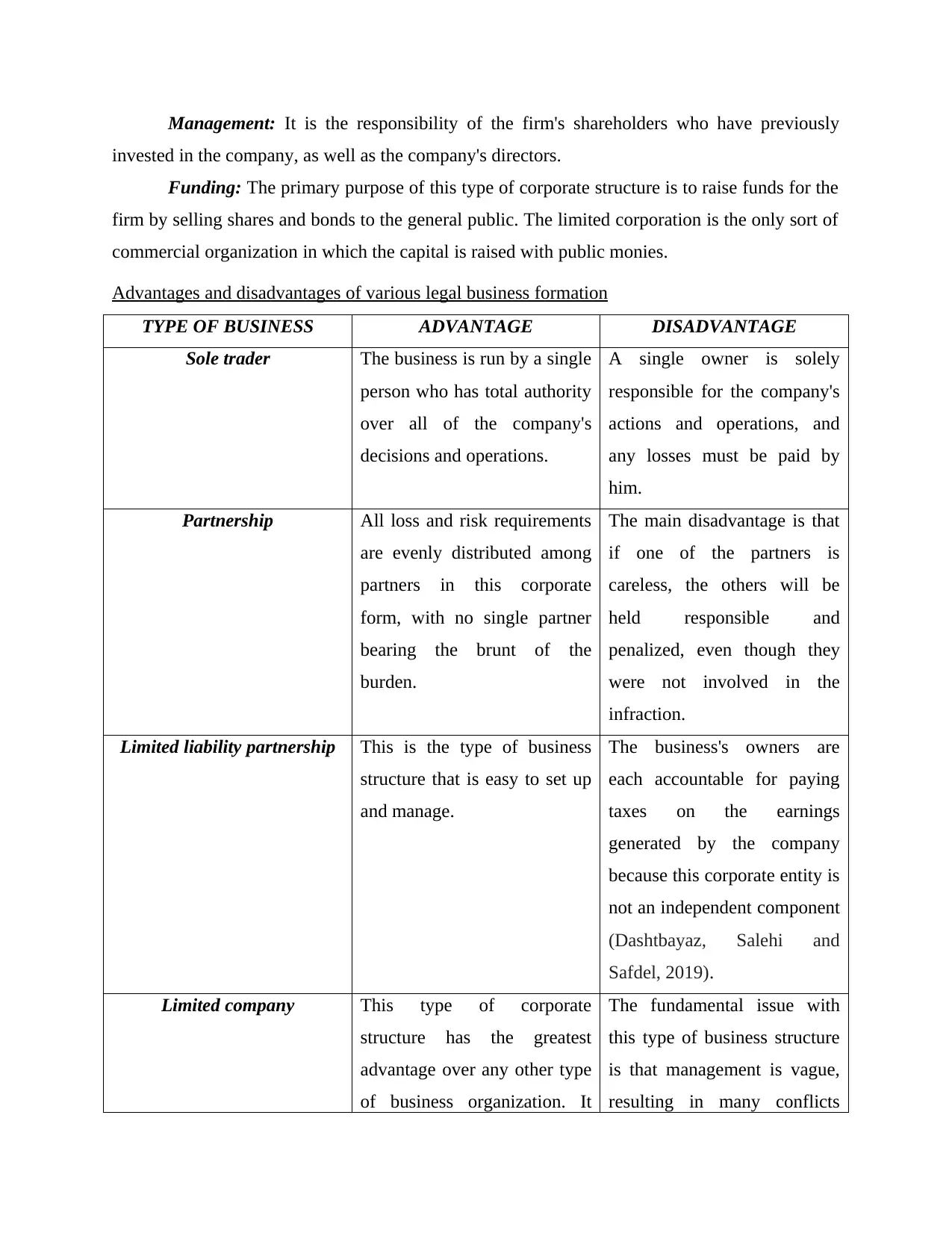
Management: It is the responsibility of the firm's shareholders who have previously
invested in the company, as well as the company's directors.
Funding: The primary purpose of this type of corporate structure is to raise funds for the
firm by selling shares and bonds to the general public. The limited corporation is the only sort of
commercial organization in which the capital is raised with public monies.
Advantages and disadvantages of various legal business formation
TYPE OF BUSINESS ADVANTAGE DISADVANTAGE
Sole trader The business is run by a single
person who has total authority
over all of the company's
decisions and operations.
A single owner is solely
responsible for the company's
actions and operations, and
any losses must be paid by
him.
Partnership All loss and risk requirements
are evenly distributed among
partners in this corporate
form, with no single partner
bearing the brunt of the
burden.
The main disadvantage is that
if one of the partners is
careless, the others will be
held responsible and
penalized, even though they
were not involved in the
infraction.
Limited liability partnership This is the type of business
structure that is easy to set up
and manage.
The business's owners are
each accountable for paying
taxes on the earnings
generated by the company
because this corporate entity is
not an independent component
(Dashtbayaz, Salehi and
Safdel, 2019).
Limited company This type of corporate
structure has the greatest
advantage over any other type
of business organization. It
The fundamental issue with
this type of business structure
is that management is vague,
resulting in many conflicts
invested in the company, as well as the company's directors.
Funding: The primary purpose of this type of corporate structure is to raise funds for the
firm by selling shares and bonds to the general public. The limited corporation is the only sort of
commercial organization in which the capital is raised with public monies.
Advantages and disadvantages of various legal business formation
TYPE OF BUSINESS ADVANTAGE DISADVANTAGE
Sole trader The business is run by a single
person who has total authority
over all of the company's
decisions and operations.
A single owner is solely
responsible for the company's
actions and operations, and
any losses must be paid by
him.
Partnership All loss and risk requirements
are evenly distributed among
partners in this corporate
form, with no single partner
bearing the brunt of the
burden.
The main disadvantage is that
if one of the partners is
careless, the others will be
held responsible and
penalized, even though they
were not involved in the
infraction.
Limited liability partnership This is the type of business
structure that is easy to set up
and manage.
The business's owners are
each accountable for paying
taxes on the earnings
generated by the company
because this corporate entity is
not an independent component
(Dashtbayaz, Salehi and
Safdel, 2019).
Limited company This type of corporate
structure has the greatest
advantage over any other type
of business organization. It
The fundamental issue with
this type of business structure
is that management is vague,
resulting in many conflicts
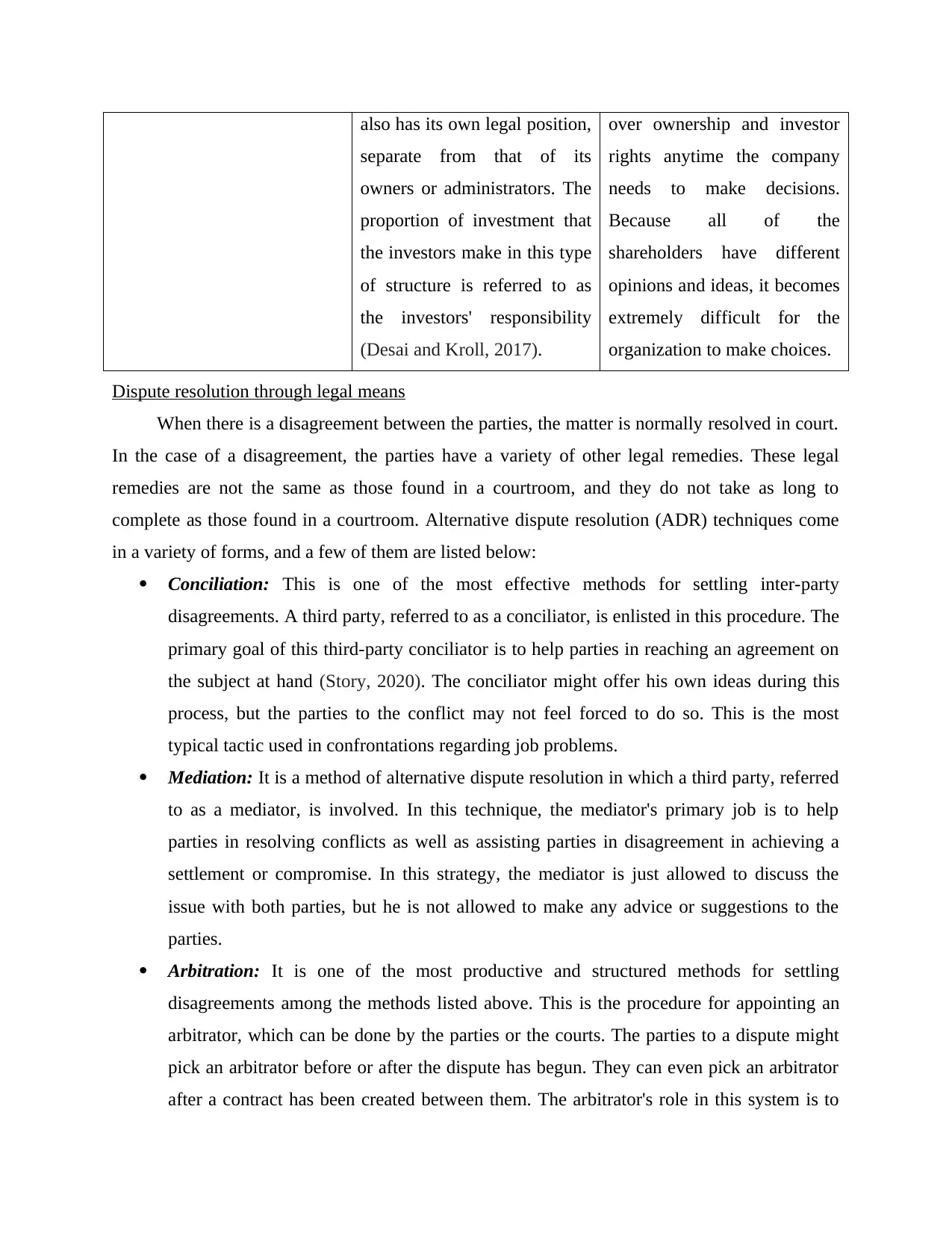
also has its own legal position,
separate from that of its
owners or administrators. The
proportion of investment that
the investors make in this type
of structure is referred to as
the investors' responsibility
(Desai and Kroll, 2017).
over ownership and investor
rights anytime the company
needs to make decisions.
Because all of the
shareholders have different
opinions and ideas, it becomes
extremely difficult for the
organization to make choices.
Dispute resolution through legal means
When there is a disagreement between the parties, the matter is normally resolved in court.
In the case of a disagreement, the parties have a variety of other legal remedies. These legal
remedies are not the same as those found in a courtroom, and they do not take as long to
complete as those found in a courtroom. Alternative dispute resolution (ADR) techniques come
in a variety of forms, and a few of them are listed below:
Conciliation: This is one of the most effective methods for settling inter-party
disagreements. A third party, referred to as a conciliator, is enlisted in this procedure. The
primary goal of this third-party conciliator is to help parties in reaching an agreement on
the subject at hand (Story, 2020). The conciliator might offer his own ideas during this
process, but the parties to the conflict may not feel forced to do so. This is the most
typical tactic used in confrontations regarding job problems.
Mediation: It is a method of alternative dispute resolution in which a third party, referred
to as a mediator, is involved. In this technique, the mediator's primary job is to help
parties in resolving conflicts as well as assisting parties in disagreement in achieving a
settlement or compromise. In this strategy, the mediator is just allowed to discuss the
issue with both parties, but he is not allowed to make any advice or suggestions to the
parties.
Arbitration: It is one of the most productive and structured methods for settling
disagreements among the methods listed above. This is the procedure for appointing an
arbitrator, which can be done by the parties or the courts. The parties to a dispute might
pick an arbitrator before or after the dispute has begun. They can even pick an arbitrator
after a contract has been created between them. The arbitrator's role in this system is to
separate from that of its
owners or administrators. The
proportion of investment that
the investors make in this type
of structure is referred to as
the investors' responsibility
(Desai and Kroll, 2017).
over ownership and investor
rights anytime the company
needs to make decisions.
Because all of the
shareholders have different
opinions and ideas, it becomes
extremely difficult for the
organization to make choices.
Dispute resolution through legal means
When there is a disagreement between the parties, the matter is normally resolved in court.
In the case of a disagreement, the parties have a variety of other legal remedies. These legal
remedies are not the same as those found in a courtroom, and they do not take as long to
complete as those found in a courtroom. Alternative dispute resolution (ADR) techniques come
in a variety of forms, and a few of them are listed below:
Conciliation: This is one of the most effective methods for settling inter-party
disagreements. A third party, referred to as a conciliator, is enlisted in this procedure. The
primary goal of this third-party conciliator is to help parties in reaching an agreement on
the subject at hand (Story, 2020). The conciliator might offer his own ideas during this
process, but the parties to the conflict may not feel forced to do so. This is the most
typical tactic used in confrontations regarding job problems.
Mediation: It is a method of alternative dispute resolution in which a third party, referred
to as a mediator, is involved. In this technique, the mediator's primary job is to help
parties in resolving conflicts as well as assisting parties in disagreement in achieving a
settlement or compromise. In this strategy, the mediator is just allowed to discuss the
issue with both parties, but he is not allowed to make any advice or suggestions to the
parties.
Arbitration: It is one of the most productive and structured methods for settling
disagreements among the methods listed above. This is the procedure for appointing an
arbitrator, which can be done by the parties or the courts. The parties to a dispute might
pick an arbitrator before or after the dispute has begun. They can even pick an arbitrator
after a contract has been created between them. The arbitrator's role in this system is to
⊘ This is a preview!⊘
Do you want full access?
Subscribe today to unlock all pages.

Trusted by 1+ million students worldwide
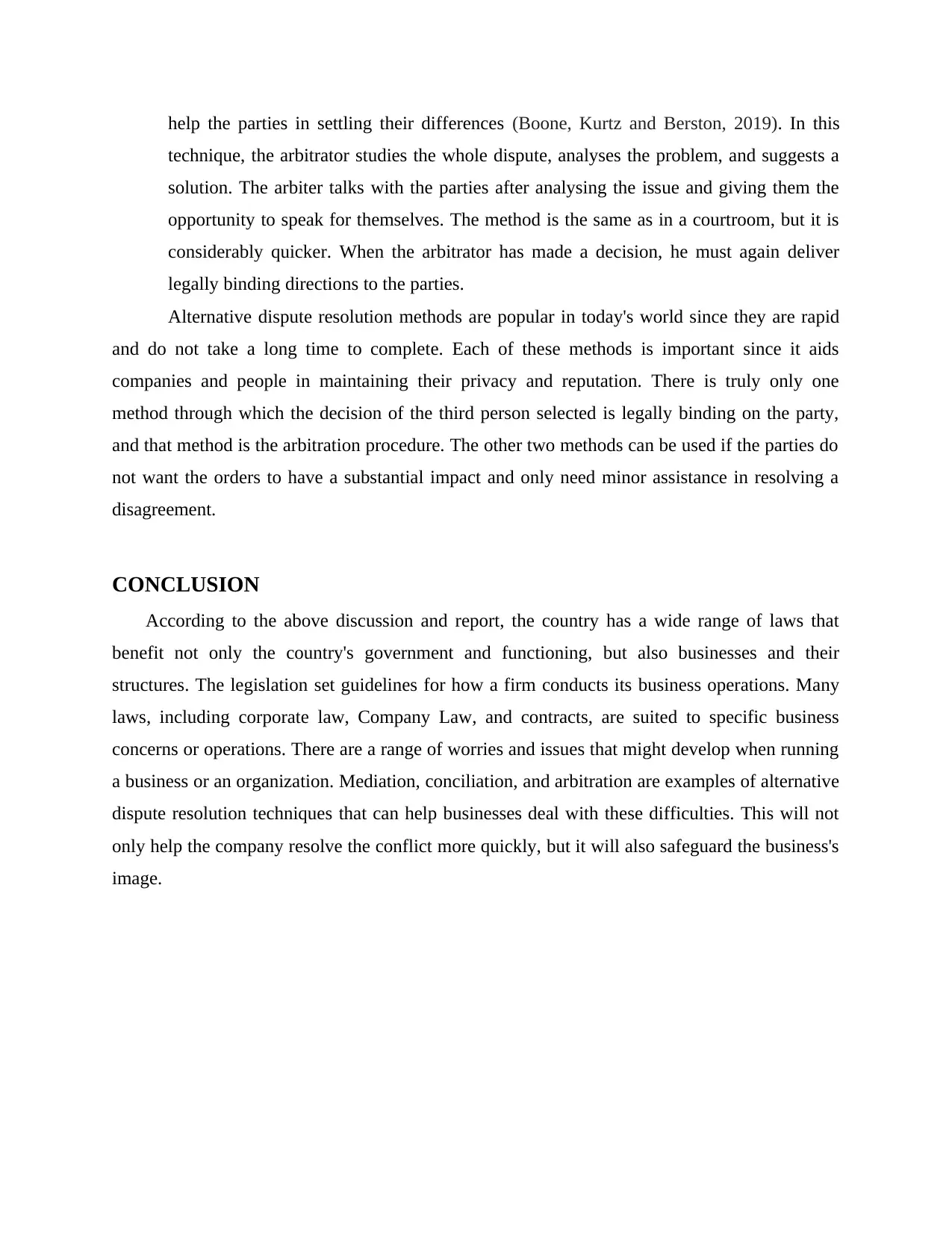
help the parties in settling their differences (Boone, Kurtz and Berston, 2019). In this
technique, the arbitrator studies the whole dispute, analyses the problem, and suggests a
solution. The arbiter talks with the parties after analysing the issue and giving them the
opportunity to speak for themselves. The method is the same as in a courtroom, but it is
considerably quicker. When the arbitrator has made a decision, he must again deliver
legally binding directions to the parties.
Alternative dispute resolution methods are popular in today's world since they are rapid
and do not take a long time to complete. Each of these methods is important since it aids
companies and people in maintaining their privacy and reputation. There is truly only one
method through which the decision of the third person selected is legally binding on the party,
and that method is the arbitration procedure. The other two methods can be used if the parties do
not want the orders to have a substantial impact and only need minor assistance in resolving a
disagreement.
CONCLUSION
According to the above discussion and report, the country has a wide range of laws that
benefit not only the country's government and functioning, but also businesses and their
structures. The legislation set guidelines for how a firm conducts its business operations. Many
laws, including corporate law, Company Law, and contracts, are suited to specific business
concerns or operations. There are a range of worries and issues that might develop when running
a business or an organization. Mediation, conciliation, and arbitration are examples of alternative
dispute resolution techniques that can help businesses deal with these difficulties. This will not
only help the company resolve the conflict more quickly, but it will also safeguard the business's
image.
technique, the arbitrator studies the whole dispute, analyses the problem, and suggests a
solution. The arbiter talks with the parties after analysing the issue and giving them the
opportunity to speak for themselves. The method is the same as in a courtroom, but it is
considerably quicker. When the arbitrator has made a decision, he must again deliver
legally binding directions to the parties.
Alternative dispute resolution methods are popular in today's world since they are rapid
and do not take a long time to complete. Each of these methods is important since it aids
companies and people in maintaining their privacy and reputation. There is truly only one
method through which the decision of the third person selected is legally binding on the party,
and that method is the arbitration procedure. The other two methods can be used if the parties do
not want the orders to have a substantial impact and only need minor assistance in resolving a
disagreement.
CONCLUSION
According to the above discussion and report, the country has a wide range of laws that
benefit not only the country's government and functioning, but also businesses and their
structures. The legislation set guidelines for how a firm conducts its business operations. Many
laws, including corporate law, Company Law, and contracts, are suited to specific business
concerns or operations. There are a range of worries and issues that might develop when running
a business or an organization. Mediation, conciliation, and arbitration are examples of alternative
dispute resolution techniques that can help businesses deal with these difficulties. This will not
only help the company resolve the conflict more quickly, but it will also safeguard the business's
image.
Paraphrase This Document
Need a fresh take? Get an instant paraphrase of this document with our AI Paraphraser
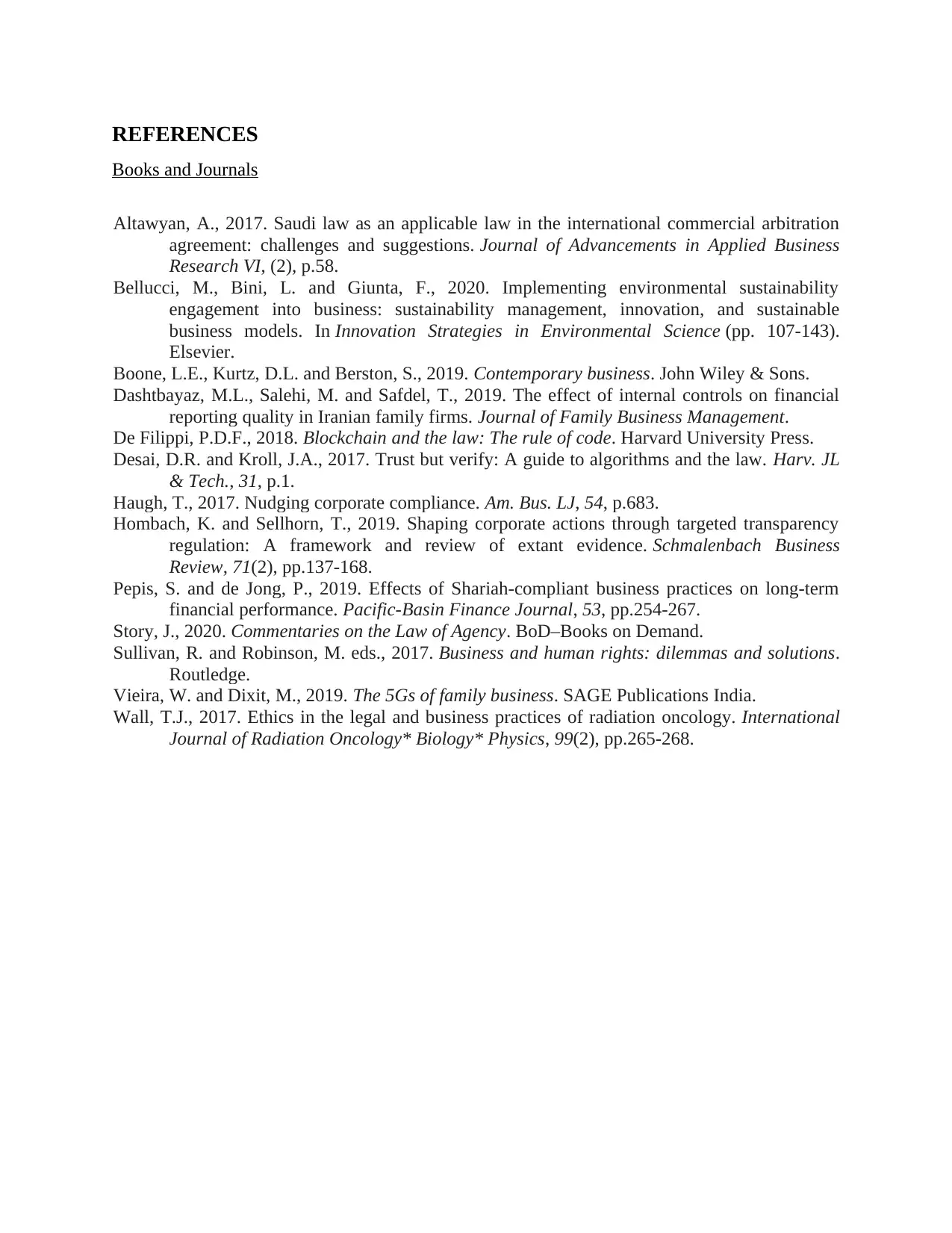
REFERENCES
Books and Journals
Altawyan, A., 2017. Saudi law as an applicable law in the international commercial arbitration
agreement: challenges and suggestions. Journal of Advancements in Applied Business
Research VI, (2), p.58.
Bellucci, M., Bini, L. and Giunta, F., 2020. Implementing environmental sustainability
engagement into business: sustainability management, innovation, and sustainable
business models. In Innovation Strategies in Environmental Science (pp. 107-143).
Elsevier.
Boone, L.E., Kurtz, D.L. and Berston, S., 2019. Contemporary business. John Wiley & Sons.
Dashtbayaz, M.L., Salehi, M. and Safdel, T., 2019. The effect of internal controls on financial
reporting quality in Iranian family firms. Journal of Family Business Management.
De Filippi, P.D.F., 2018. Blockchain and the law: The rule of code. Harvard University Press.
Desai, D.R. and Kroll, J.A., 2017. Trust but verify: A guide to algorithms and the law. Harv. JL
& Tech., 31, p.1.
Haugh, T., 2017. Nudging corporate compliance. Am. Bus. LJ, 54, p.683.
Hombach, K. and Sellhorn, T., 2019. Shaping corporate actions through targeted transparency
regulation: A framework and review of extant evidence. Schmalenbach Business
Review, 71(2), pp.137-168.
Pepis, S. and de Jong, P., 2019. Effects of Shariah-compliant business practices on long-term
financial performance. Pacific-Basin Finance Journal, 53, pp.254-267.
Story, J., 2020. Commentaries on the Law of Agency. BoD–Books on Demand.
Sullivan, R. and Robinson, M. eds., 2017. Business and human rights: dilemmas and solutions.
Routledge.
Vieira, W. and Dixit, M., 2019. The 5Gs of family business. SAGE Publications India.
Wall, T.J., 2017. Ethics in the legal and business practices of radiation oncology. International
Journal of Radiation Oncology* Biology* Physics, 99(2), pp.265-268.
Books and Journals
Altawyan, A., 2017. Saudi law as an applicable law in the international commercial arbitration
agreement: challenges and suggestions. Journal of Advancements in Applied Business
Research VI, (2), p.58.
Bellucci, M., Bini, L. and Giunta, F., 2020. Implementing environmental sustainability
engagement into business: sustainability management, innovation, and sustainable
business models. In Innovation Strategies in Environmental Science (pp. 107-143).
Elsevier.
Boone, L.E., Kurtz, D.L. and Berston, S., 2019. Contemporary business. John Wiley & Sons.
Dashtbayaz, M.L., Salehi, M. and Safdel, T., 2019. The effect of internal controls on financial
reporting quality in Iranian family firms. Journal of Family Business Management.
De Filippi, P.D.F., 2018. Blockchain and the law: The rule of code. Harvard University Press.
Desai, D.R. and Kroll, J.A., 2017. Trust but verify: A guide to algorithms and the law. Harv. JL
& Tech., 31, p.1.
Haugh, T., 2017. Nudging corporate compliance. Am. Bus. LJ, 54, p.683.
Hombach, K. and Sellhorn, T., 2019. Shaping corporate actions through targeted transparency
regulation: A framework and review of extant evidence. Schmalenbach Business
Review, 71(2), pp.137-168.
Pepis, S. and de Jong, P., 2019. Effects of Shariah-compliant business practices on long-term
financial performance. Pacific-Basin Finance Journal, 53, pp.254-267.
Story, J., 2020. Commentaries on the Law of Agency. BoD–Books on Demand.
Sullivan, R. and Robinson, M. eds., 2017. Business and human rights: dilemmas and solutions.
Routledge.
Vieira, W. and Dixit, M., 2019. The 5Gs of family business. SAGE Publications India.
Wall, T.J., 2017. Ethics in the legal and business practices of radiation oncology. International
Journal of Radiation Oncology* Biology* Physics, 99(2), pp.265-268.
1 out of 11
Related Documents
Your All-in-One AI-Powered Toolkit for Academic Success.
+13062052269
info@desklib.com
Available 24*7 on WhatsApp / Email
![[object Object]](/_next/static/media/star-bottom.7253800d.svg)
Unlock your academic potential
Copyright © 2020–2025 A2Z Services. All Rights Reserved. Developed and managed by ZUCOL.





